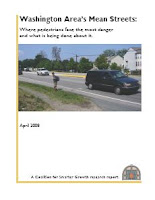 Every year, more than 75 pedestrians are killed and 1,000 injured in the Washington metropolitan area, according to the Coalition for Smarter Growth in its report, “Washington’s Mean Streets.” There is a close correlation between land use patterns and the incidence of pedestrian accidents, especially fatal ones.
Every year, more than 75 pedestrians are killed and 1,000 injured in the Washington metropolitan area, according to the Coalition for Smarter Growth in its report, “Washington’s Mean Streets.” There is a close correlation between land use patterns and the incidence of pedestrian accidents, especially fatal ones.
Calculating a “pedestrian danger index” based upon pedestrian fatalities per 100,000 people and adjusted for the percentage of the population that walks to work, the Coalition for Smarter Growth compiled the following rankings (from most dangerous to safest) of the region’s largest jurisdictions:
1. Fairfax County: 44.1
2. Prince George’s County, Md.: 42.6
3. Prince William County: 33.1
4. Montgomery County, Md.: 24.4
5. Loudoun County: 20.6
6. District of Columbia: 10.0
7. Arlington County: 9.6
8. Alexandria: 7.8
For remedies, the Coalition recommends:
- Fix the worst places. Indentify and fix high-crash/high-risk intersections and roadways.
- Complete the streets: Ensure that all streets and intersections are built and operated for the safety and convenience of all users, not just automobiles.
- Institutionalize changes: Update standards in all relevant planning, design,and maintenance manuals. Invest in training all transportation and development reviewprofessionals on new complete streets policies. Replace vehicle “level of service” measures with multi-modal performance measures.
- Build mixed-use walkable places: Local governments should guide new development and retrofit existing development to create mixed-use, walkable environments that make walking, bicycling, and access to transit safe and convenient choices. The long-term solution to pedestrian safety problems lies in creating places that offer a comfortable and walkable environment in which homes, businesses, services, and community facilities are linked by a highly connected street grid of short blocks, lined with street-oriented buildings and pedestrian-scaled civic spaces.


